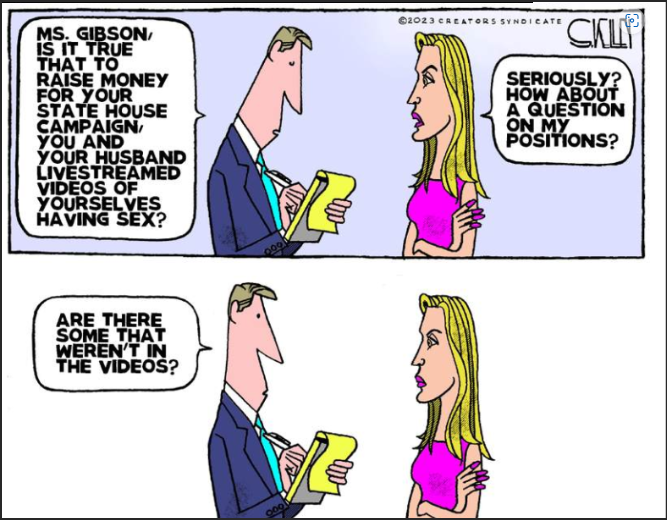About
Bacon's Rebellion is Virginia's leading politically non-aligned portal for news, opinions and analysis about state, regional and local public policy. Read more about us here.Fund the Rebellion
Shake up the status quo!
Your contributions will be used to pay for faster download speeds and grow readership. Make a one-time donation by credit card or contribute a small sum monthly.
Can't wait until tomorrow for your Bacon's Rebellion fix?
Search Bacon’s Rebellion
Content Categories
Archives
The Jefferson Council: Protecting Thomas Jefferson’s Legacy at the University of Virginia

Forgot Your Password?
Shoot me an email and I'll generate a new password for you.-
Recent Posts
- Youngkin Kills Tax Hikes, Still Gets Record Budget
- Mother’s Day in Virginia
- Jeanine’s Memes
- Bacon Meme of the Week
- The Crying Game
- So Much for Empathetic Listening
- No Need to Call the Budget Bluff
- FUCK UVA Redux: The Revolution Consumes Its Own
- Has the Rural Brain Drain Ended?
- UVA Soft on Nazis but Brutal to Students?
- Spying in Salem
- Team Ryan Defends Shutdown of Tent Encampment
- Intellectuals Yet Idiots on the Loose
- Parking Decks, Debt, & Trap Doors
- Ignoring FOIA?
Category Archives: Uncategorized
Giant Utility Rejects Net Zero Power; Big Fight Follows
 by David Wojick
by David Wojick
Dominion Energy, Virginia’s big electric utility, is telling the state it does not foresee complying with the 2045 net zero power target in the Virginia Clean Economy Act (VCEA). The preferred option in Dominion’s latest Integrated Resources Plan (IRP) retires no fossil-fueled power generators, other than the few old ones that are already in the process of retirement. In fact, it adds a lot more fossil juice.
Up front in the IRP, Dominion puts it this way: “Due to an increasing load forecast, and the need for dispatchable generation, the Alternative Plans show additional natural-gas-fired resources and preserve existing carbon-emitting units beyond statutory retirement deadlines established in the VCEA. The law explicitly authorizes the Company to petition the SCC for relief from these requirements on the basis that the unit retirements would threaten the reliability or security of electric service to customers.”
So, in effect, this is a notice to Virginia’s utility regulator, the State Corporation Commission (SCC), that Dominion is prepared to petition for permission to not comply with the net zero power generation mandate in the VCEA. Continue reading
Virginia Colleges Fare Pretty Well in 2024 FIRE Rankings
In case you’re wondering how all Virginia institutions scored in the 2024 FIRE free speech rankings, here is a summary of the universities included in the survey. For perspective, I’ve included the top and bottom scorers. Liberty University is listed separately, as it is one of six that prioritize other values over free speech. Remember, the rankings reflect an assessment of formal written policies, not actual practice or campus climate. — JAB
| 2024 FIRE Free Speech Ranking | |||
| Rank | Institution | Score | Speech Climate |
| #1 | Michigan Technological University | 78.01 | Good |
| #6 | University of Virginia | 68.00 | Above Average |
| #8 | George Mason University | 67.67 | Above Average |
| #20 | Washington & Lee University | 62.99 | Above Average |
| #26 | James Madison University | 58.83 | Slightly Above Average |
| #59 | College of William and Mary | 53.69 | Average |
| #160 | Virginia Tech | 42.17 | Slightly Below Average |
| #184 | Virginia Commonwealth University | 39.23 | Below Average |
| #248 | Harvard University | 0 | Abysmal |
| Liberty University | 35.62 | Warning, No Rank | |
Posted in Uncategorized
Hey, Preppers, Check Out Virginia!
I always suspected this might be the case, but now there is hard data to back it up. Non-coastal Virginia is one of the lowest-risk areas in the country for natural disasters. Sure, we get the occasional tornado or flood, but, really, how often? And when was the last time we experienced a deadly wildfire, hail storm or volcanic eruption?
Gutter Gnome, a gutter installation company, drew upon FEMA’s National Risk Index to identify the ten cities in the United States safest from natural disasters. Virginia snagged the top three. The list:
- Richmond
- Lynchburg
- Roanoke
- Midland, TX
- Duluth, MN
- Rochester, MN
- Pittsburgh, PA
- Tyler, TX
- Bloomington, IN
- Boise, ID
Oddly, Compton, Va., a community in Page County, Va., appeared on the list of riskiest “cities” for natural disasters. No explanation given. Must have had a bad flood or landslide.
Here are the categories of natural disasters, incorporating data from exposure, frequency, and historic loss ratio, that FEMA tracks: avalanche, coastal flooding, cold waves, droughts, earthquakes, hail, heat waves, hurricanes, ice storms, landslides, lightning, riverine flooding, strong wind, tornado, tsunami, volcanic activity, wildfire, and winter weather.
— JAB
Posted in Uncategorized
A Concept for Simpler and More Compliant Virginia Regulation of Medical Facilities and Services in Virginia
By James C. Sherlock
I saw a comment somewhere that medical facilities are the second most regulated industry in America, just behind nuclear power.
Yet we see that it has not been working in Virginia in the case of nursing homes. And compliance is considerably harder in the other medical facilities and services in Virginia than it needs to be.
A big part of the reason is that Virginia has laws and regulations that either:
- Do not implement federal laws or regulations that require the state to do so for facilities accepting Medicare or Medicaid/Children’s Health Improvement Program (CHIP); or
- Conflict with the Social Security Act and its executing regulations, which take precedence in the case of those federally-funded programs; or
- Both.
In case of omission or conflict with the federal guidelines, state laws and regulations do not add value, just complexity and confusion.
And to no avail.
Posted in Uncategorized
Improper Parking and Other Unlikely Tales
 by Joe Fitzgerald
by Joe Fitzgerald
Drunk driving and gerrymandering don’t usually go hand in hand, but there are exceptions. The race-based district-drawing skills of Virginia Democrats half a century ago had areas around majority black Petersburg represented in the state Senate by a rural Democrat from Windsor, 50 miles east. When the state senator got a DUI on his home turf, fickle memory tells me, the hearing was too far away for the local paper to send a reporter.
The charge was probably reduced to improper driving. That’s a standard go-to when the various officers of the court know a guy was drinking but don’t think driving under the influence can be proven. I covered the case in Sussex County in 1984 of a man who had passed out, driven his car into a ditch, and slid over against the passenger door. He admitted to the officer who found him that he had been driving the car when it ran off the road. Continue reading
Posted in Uncategorized
Correction
by James A. Bacon
In two recent stories about administrative bloat and faculty bloat at the University of Virginia, I published inaccurate information. I stated that annualized full-time-equivalent student enrollment between fiscal 2012 and fiscal 2022 increased 1.1%. The correct figure was 8.8%. The result of the error was to exaggerate the degree to which the increase in salaried staff and teaching faculty outpaced the increase in student enrollment.
However, the larger point of the articles stands: the increase in staff and faculty exceeded that of enrollment by a wide margin. The headcount of salaried staff increased 25.4% over the same period and the headcount of tenure-track faculty, instructors, and lecturers increased 25.7%.
Posted in Uncategorized
Hard Numbers on Administrative Bloat

That bloated feeling. Image credit: Microsoft Image Creator
by James A. Bacon
A number of University of Virginia Board of Visitors members have expressed concern about UVa’s runaway costs. Administrative bloat has swollen the university’s cost structure, they say, and higher costs have been cited in turn to justify tuition increases. So far, the fiscal hawks have been unable to force a discussion of the topic during regular board meetings. Indeed, simple requests for data on headcounts and salary costs have gone unanswered.
The refusal of UVa leadership to share the data is all the more remarkable in that the statistics are readily available. Indeed, much of it is maintained on the UVa website by the office of Institutional Research & Analytics (IR&A). The 17 members of the IR&A staff have the mission of supporting “the University community” — which, presumably, includes the Board of Visitors — in “assessment, planning, and decision-making.”
As it turns out, the IR&A data confirm the suspicions of the fiscal hawks. Between the 2011-12 academic year and the 2021-22 year, UVa’s academic division (excluding the healthcare division) saw the ranks of salaried staff grow dramatically — at twice the pace of faculty — even as enrollment barely budged.
Student enrollment (full-time-equivalent): +8.8%
Total faculty: +9.5%
Total salaried staff: +25.4%
Continue reading
Posted in Education (higher ed), Uncategorized
Tagged James A. Bacon, University of Virginia
JLARC Report: More Than Just “Mo’ Money”

Photo credit: Va. Dept of Education
by Dick Hall-Sizemore
The Joint Legislative Audit and Review Commission (JLARC) released a major report last month on the Commonwealth’s K-12 funding formula. The responses were predictable.
On Bacon’s Rebellion, Jim Bacon dismissed the report as a cry for “mo’ money.” Democrats in the General Assembly seized upon the report and its findings as more ammunition in their fight against Governor Youngkin’s effort to cut taxes further.
It is true that the report concludes that the state needs to provide more funding for K-12. However, the report is much more than that. In the report, JLARC documents serious deficiencies in the formula that is used to calculate funding for K-12. It then proposes some significant changes that could be made that would improve the funding system. The report deserves a deeper look on this blog than it has received. Continue reading









